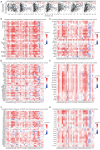Bioinformatics analysis reveals VEGFC's prognostic significance in head and neck squamous cell carcinoma and its association with immune cell infiltration
- PMID: 39697755
- PMCID: PMC11651743
- DOI: 10.21037/tcr-24-834
Bioinformatics analysis reveals VEGFC's prognostic significance in head and neck squamous cell carcinoma and its association with immune cell infiltration
Abstract
Background: Head and neck squamous cell carcinoma (HNSCC) has a poor prognosis due to late diagnosis and complex molecular mechanisms. Vascular endothelial growth factor C (VEGFC) is associated with angiogenesis and lymphangiogenesis. This study aimed to investigate VEGFC's prognostic value in HNSCC and its correlation with immune cell infiltration.
Methods: VEGFC gene expression was analyzed in HNSCC patients using Tumor Immune Estimation Resource 2.0 (TIMER2.0), Gene Expression Profiling Interactive Analysis (GEPIA), and University of ALabama at Birmingham CANcer data analysis Portal (UALCAN) databases, focusing on differential expression and clinical-pathological correlations. The impact of VEGFC on overall survival (OS) and disease-free survival (DFS) was assessed using GEPIA. RNA-seq profiles and clinical information from 503 HNSCC tumor tissues and 44 normal control tissues obtained from The Cancer Genome Atlas (TCGA) database were subjected to univariate and multivariate Cox regression analyses to develop a prognostic nomogram. The Search Tool for the Retrieval of Interacting Genes/Proteins (STRING) database was used for a protein-protein interaction (PPI) network, while the Tumor-Immune System Interaction Database (TISIDB) for immune-related associations. Expression was further validated with the Gene Expression Omnibus dataset (GSE6631) and reverse transcription quantitative polymerase chain reaction (RT-qPCR).
Results: VEGFC was significantly upregulated in HNSCC and closely correlated with age, gender, race, and tumor stage (P<0.05). PPI and co-expression gene analysis identified ITGA3, NT5E, and PXN as highly associated with VEGFC (R>0.6, P<0.05), which are mainly enriched in PI3K/Akt, MAPK signaling pathway, and cancer-associated glycoproteins. High VEGFC expression predicted poor OS (P=0.003) and DFS (P=0.03). Univariate and multivariate Cox regression analyses confirmed VEGFC as an independent prognostic factor for HNSCC. The prognostic nomogram accurately predicted 1-, 3-, and 5-year survival and calibration curve was very close to ideal 45-degree diagonal line. VEGFC also correlated with immune cells infiltration, including B cells, CD4+ T cells, CD8+ T cells, as well as immune-related markers such as tumor-infiltrating lymphocytes (TILs) markers, immune modulators, and inflammatory chemokines (P<0.05).
Conclusions: VEGFC may serve as an independent prognostic factor and potential immunotherapeutic target in HNSCC, offering insights into patient risk stratification and personalized treatment strategies.
Keywords: Vascular endothelial growth factor C (VEGFC); bioinformatics; head and neck squamous cell carcinoma (HNSCC); immune infiltration; prognosis.
2024 AME Publishing Company. All rights reserved.
Conflict of interest statement
Conflicts of Interest: All authors have completed the ICMJE uniform disclosure form (available at https://tcr.amegroups.com/article/view/10.21037/tcr-24-834/coif). The authors have no conflicts of interest to declare.
Figures








Similar articles
-
Identification of HOXB9 based on comprehensive bioinformatics analysis for predicting prognosis of head and neck squamous cell carcinoma.Medicine (Baltimore). 2023 Sep 1;102(35):e35035. doi: 10.1097/MD.0000000000035035. Medicine (Baltimore). 2023. PMID: 37657018 Free PMC article.
-
Overexpression of TPD52L2 in HNSCC: prognostic significance and correlation with immune infiltrates.BMC Oral Health. 2024 Oct 7;24(1):1191. doi: 10.1186/s12903-024-04977-1. BMC Oral Health. 2024. PMID: 39375696 Free PMC article.
-
Identification and verification of eight cancer-associated fibroblasts related genes as a prognostic signature for head and neck squamous cell carcinoma.Heliyon. 2023 Feb 28;9(3):e14003. doi: 10.1016/j.heliyon.2023.e14003. eCollection 2023 Mar. Heliyon. 2023. PMID: 36938461 Free PMC article.
-
Seven Immune-Related Genes' Prognostic Value and Correlation with Treatment Outcome in Head and Neck Squamous Cell Carcinoma.Mediators Inflamm. 2023 Apr 20;2023:8533476. doi: 10.1155/2023/8533476. eCollection 2023. Mediators Inflamm. 2023. PMID: 39282247 Free PMC article.
-
CELSR3 is a prognostic marker in HNSCC and correlates with immune cell infiltration in the tumor microenvironment.Eur Arch Otorhinolaryngol. 2024 Jun;281(6):3143-3156. doi: 10.1007/s00405-024-08566-4. Epub 2024 Mar 20. Eur Arch Otorhinolaryngol. 2024. PMID: 38507078 Free PMC article.
Cited by
-
Machine Learning-Assisted Analysis of the Oral Cancer Immune Microenvironment: From Single-Cell Level to Prognostic Model Construction.J Cell Mol Med. 2025 Jun;29(11):e70637. doi: 10.1111/jcmm.70637. J Cell Mol Med. 2025. PMID: 40457149 Free PMC article.
-
Immunological role and prognostic value of ITGA3 and ITGA5 in oral squamous cell carcinoma.Sci Rep. 2025 Aug 17;15(1):30046. doi: 10.1038/s41598-025-16026-0. Sci Rep. 2025. PMID: 40820179 Free PMC article.
References
LinkOut - more resources
Full Text Sources
Research Materials
Miscellaneous
